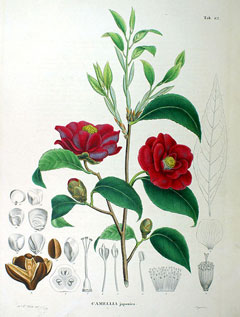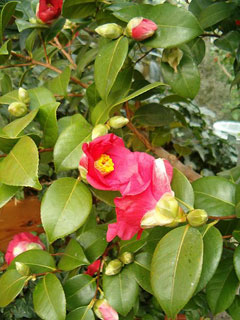 |
|
http://commons.wikimedia.org/wiki/File:Camellia_japonica_SZ82.jpg |
 |
| http://commons.wikimedia.org/wiki/User:BotBln |
Translate this page:
Summary
Bloom Color: Lavender, Orange, Pink, Red, White, Yellow.
Main Bloom Time: Early spring, Early winter, Late fall, Late winter, Mid winter. Form: Oval.
Physical Characteristics

 Camellia japonica is an evergreen Shrub growing to 10 m (32ft) by 8 m (26ft) at a slow rate.
Camellia japonica is an evergreen Shrub growing to 10 m (32ft) by 8 m (26ft) at a slow rate.
See above for USDA hardiness. It is hardy to UK zone 7 and is not frost tender. It is in leaf all year, in flower from April to June, and the seeds ripen in October. The species is hermaphrodite (has both male and female organs) and is pollinated by Bees.
Suitable for: light (sandy) and medium (loamy) soils and prefers well-drained soil. Suitable pH: mildly acid and neutral soils and can grow in very acid soils.
It can grow in full shade (deep woodland) semi-shade (light woodland) or no shade. It prefers moist soil.
UK Hardiness Map
US Hardiness Map
Synonyms
Thea japonica.
Plant Habitats
Woodland Garden Sunny Edge; Dappled Shade; Shady Edge;
Edible Uses
Edible Parts: Flowers Oil Oil
Edible Uses: Oil Oil Tea
An edible oil is obtained from the seed[11, 61, 105]. It is called 'tsubaki oil'[183]. Dried flowers - cooked[105]. Used as a vegetable or mixed with gelatinous-rice to make a Japanese food called 'mochi'[183]. The leaves are a tea substitute[142, 177, 178, 183].
References More on Edible Uses
Medicinal Uses
Plants For A Future can not take any responsibility for any adverse effects from the use of plants. Always seek advice from a professional before using a plant medicinally.
Astringent Cancer Haemostatic Salve Tonic
The flowers are astringent, antihaemorrhagic, haemostatic, salve and tonic[178, 218]. When mixed with sesame oil they are used in the treatment of burns and scalds[218]. The plant has shown anticancer activity[218].
References More on Medicinal Uses
The Bookshop: Edible Plant Books
Our Latest books on Perennial Plants For Food Forests and Permaculture Gardens in paperback or digital formats.

Edible Tropical Plants
Food Forest Plants for Hotter Conditions: 250+ Plants For Tropical Food Forests & Permaculture Gardens.
More

Edible Temperate Plants
Plants for Your Food Forest: 500 Plants for Temperate Food Forests & Permaculture Gardens.
More

More Books
PFAF have eight books available in paperback and digital formats. Browse the shop for more information.
Shop Now
Other Uses
Dye Oil Oil
A non-drying oil is obtained from the seed - used as a hair-dressing[46, 61]. The oil consists mainly of olein it is not subject to polymerize or oxidize, nor does it form solids at low temperatures[174]. A green dye is obtained from the pink or red petals[168].
Special Uses
Espalier
References More on Other Uses
Cultivation details
Landscape Uses:Border, Container, Espalier, Standard, Specimen. Prefers a woodland soil but thrives in a warm open well-drained loam if leafmould is added[1, 11, 200]. A calcifuge plant, preferring a pH around 5[11, 200]. Prefers the partial shade of a light woodland[200], it also grows well on a north-west aspect[11] and on sunless walls[202]. This is a very cold hardy plant, but it cannot tolerate cold winds[11]. Plants should be given a position shaded from the morning sun in order to protect the flowers from late frosts[219]. Prefers a wet summer and a cool but not very frosty dry winter[200]. Plants are not very self-compatible, self-fertilized flowers produce few seeds and these are of low viability[200]. A very ornamental plant[11]. A large amount of named forms have been developed, mainly for their ornamental value[11, 200]. Many of them tolerate full sun[182, 200]. Camellias are a valuable commercial crop in Asia, where they are cultivated for the oil obtained from their seed. Many of the cultivars grown in Britain do not set seed, unfortunately. The following cultivars have been seen with good crops of seeds:- 'Alba Simplex'; 'Coppelia'; 'Guillio Nuccio'; 'Jupiter'[K].The sub-species C. japonica macrocarpa. Masam. has larger fruits than the type, looking like small apples. The sub-species C. japonica rusticana (Honda.)Kitamura. is a hardier form from N. Japan where it grows at higher altitudes than the species and withstands long snowy winters[11, 219].Special Features:Attractive foliage, Not North American native, Blooms are very showy.
References Carbon Farming Information and Carbon Sequestration Information
Temperature Converter
Type a value in the Celsius field to convert the value to Fahrenheit:
Fahrenheit:
The PFAF Bookshop
Plants For A Future have a number of books available in paperback and digital form. Book titles include Edible Plants, Edible Perennials, Edible Trees,Edible Shrubs, Woodland Gardening, and Temperate Food Forest Plants. Our new book is Food Forest Plants For Hotter Conditions (Tropical and Sub-Tropical).
Shop Now
Plant Propagation
Seed - can be sown as soon as it is ripe in a greenhouse[113]. Stored seed should be pre-soaked for 24 hours in warm water and the hard covering around the micropyle should be filed down to leave a thin covering[78, 113, 138]. It usually germinates in 1 - 3 months at 23°c[138]. Prick out the seedlings into individual pots when they are large enough to handle and grow them on in light shade in the greenhouse for at least their first winter. Plant them out into their permanent positions when they are more than 15cm tall and give them some protection from winter cold for their first year or three outdoors[K]. Cuttings of almost ripe wood, 10 - 15cm with a heel, August/September in a shaded frame. High percentage but slow[78]. Cuttings of firm wood, 7 - 10cm with a heel, end of June in a frame[11, 78]. Keep in a cool greenhouse for the first year[11]. Leaf-bud cuttings, July/August in a frame.
Other Names
If available other names are mentioned here
False flax, Gold of pleasure, Kamelia jepang, Mawar musim dingin, Rose of winter, Shancha, Siberian oil seed, Trahoa nhat, Tsitsmati,
Native Range
TEMPERATE ASIA: Japan (Honshu, Kyushu, Ryukyu Islands, Shikoku), Korea, South
Weed Potential
Right plant wrong place. We are currently updating this section.
Please note that a plant may be invasive in one area but may not in your area so it's worth checking.
Conservation Status
IUCN Red List of Threatened Plants Status :

Growth: S = slow M = medium F = fast. Soil: L = light (sandy) M = medium H = heavy (clay). pH: A = acid N = neutral B = basic (alkaline). Shade: F = full shade S = semi-shade N = no shade. Moisture: D = dry M = Moist We = wet Wa = water.
Now available:
Food Forest Plants for Mediterranean Conditions
350+ Perennial Plants For Mediterranean and Drier Food Forests and Permaculture Gardens.
[Paperback and eBook]
This is the third in Plants For A Future's series of plant guides for food forests tailored to
specific climate zones. Following volumes on temperate and tropical ecosystems, this book focuses
on species suited to Mediterranean conditions—regions with hot, dry summers and cool, wet winters,
often facing the added challenge of climate change.
Read More
Expert comment
Author
L.
Botanical References
1158200
Links / References
For a list of references used on this page please go here
Readers comment